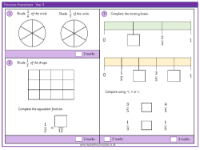Fractions - Vocabulary - Planning

Maths Resource Description
In the Year 3 curriculum, students are introduced to the fundamental concepts of fractions to enhance their mathematical understanding. The term 'numerator' refers to the top number in a fraction, indicating the number of equal parts being considered. Conversely, the 'denominator' is the bottom number, which reveals how many equal parts the whole is divided into. A 'fraction' itself represents an equal part of a whole, such as one half, one quarter, or one third, depending on the division. The concept of 'equal' is crucial, as it ensures that each part of the fraction is the same size, while 'unequal' denotes parts that are not the same.
Different types of fractions are also covered, including 'unit fractions', where the numerator is one, and 'non-unit fractions', where it is greater than one. The term 'whole' denotes a complete object or quantity, such as a whole pizza, which can be divided into 'halves', 'quarters', 'thirds', 'eighths', or 'tenths', indicating two, four, three, eight, or ten equal parts, respectively. A 'fraction wall' is a visual tool used to represent fractions as parts of a whole number. Additionally, 'decimals' are introduced as another way to represent parts of a whole, with a decimal point separating the whole number from the fractional part. The curriculum also explores 'equivalent fractions', which are different fractions that represent the same amount, and provides strategies to 'compare fractions', 'order fractions', and understand concepts like 'ascending' and 'descending' in the context of fractions.


